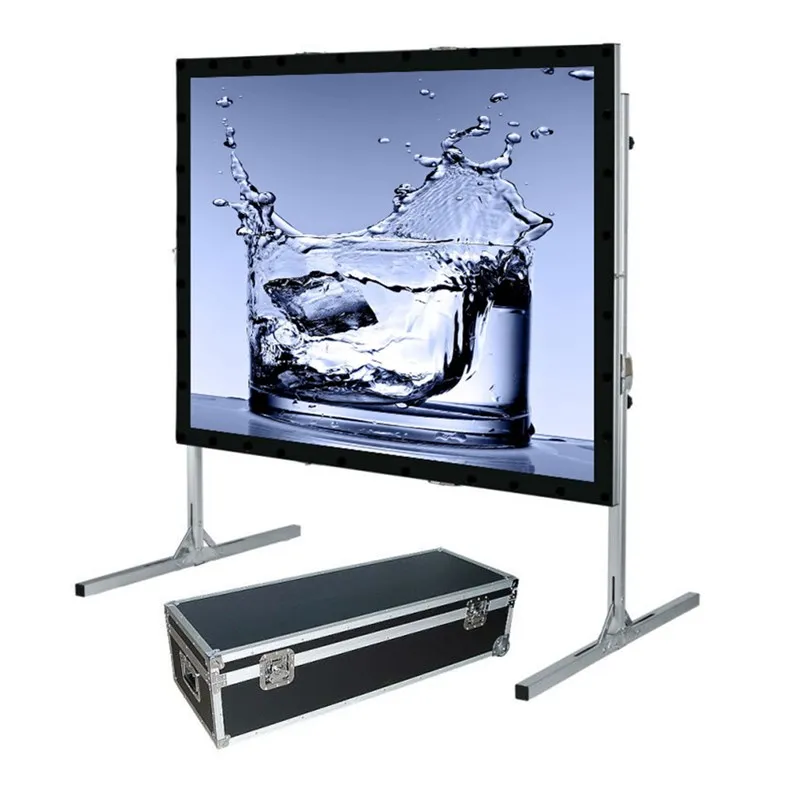

Gerriets projection screens will hang out flat and wrinkle free in about 8 hours when tied onto a pipe or truss at the top edge and weighted in the bottom with a pipe (typical hanging method for most theatrical drops ). A common misconception is to think that the screen needs to be tensioned on all 4 sides to produce a flat, taught surface. Hanging:For a projected image to look good, the screen surface must be flat and wrinkle free.Mounting methods depend on size and shape of Projection Screen An easy way to identify the embossed side of any custom-made Gerriets projection screen is to look for the grommet/eyelet marked with the Gerriets name. For both front and rear projection, the screen’s embossing should always face the viewer/audience. Most of our projection screens have a slight embossing on one side that helps direct the light that is projected on or transmitted through the screen. Inflatable screens with air valves are also available.

This method also allows the production of high-gloss vinyl film and other PVC screens. This process encompasses several steps which produce nearly invisible seams.
#PROJECTION SCREENS PROFESSIONAL#
Gerriets employs a state-of-the-art high-frequency welding process to manufacture top-quality, professional welded projection screens. The overall weight of the screen should be considered when planning or purchasing a custom size projection screen. Unfortunately, reinforced screen material is only available for front projection screens. For screens that are higher than they are wide, we generally recommend reinforced screen materials to prevent "hour-glassing" on the sides and sagging in the middle. There is no limit to the width of a screen, but there are practical and physical limitations to height. Our high-frequency welding process allows the production of custom projection screens in almost any shape and size. Most Gerriets projection screens are custom manufactured to the customer‘s specification. General Information on Projection Screens Custom Projection Screen Sizes Some “hot spotting” may occur depending on screen surface used.Projector placement behind screen - Sometimes space is not available.Screen tends to “disappear” when image is not projected due to darker color.ĭisadvantages of Rear Projection Screens:.No need to worry about shadows cast from projector.

Ambient light less of a concern as compared to front projection because color is typically grey or black (does not reflect as much light as a light colored surface).Several factors must be considered when deciding which rear projection screen to use such as the type of projector being used, the brightness of the projector, projector placement/distance relative to the screen surface, ambient light level, viewing cone needed and color of the screen. There are several types of rear projection screens ranging from very bright, narrow viewing areas to very even, wide viewing areas. The light source is on the opposite side of the viewer, thus the viewer is looking at transmitted light through the projection surface. Light sources can be a projector, traditional lighting fixture (ellipsoidal's, fresnel's, parcan's) or intelligent moving lights placed behind the rear projection screen. Rear projection is a method of transmitting light through the surface of the projection screen. Typically brighter projectors needed when other lighting is on stage (ambient light) at same time projection is on.Shadows can be cast by performers and/or scenery.Large, light colored surface attracts ambient light.No need for projector placement behind screen.ĭisadvantages of Front Projection Screens:.Cinema screens are usually front projection screens. As with both front and rear projection, controlling ambient light (all light in the space produced by sources other than the screen) will be crucial when trying to maintain image brightness. High-gain front projection screens (gain value of over 1.0) typically are brighter on center axis than matte white screens and fall off (lose brightness and clarity) at the sides. Matte-white front projection screens are typically designed to evenly maintain image brightness, clarity and contrast across its surface. The light source and viewer are on the same side of the screen, thus the viewer is looking at reflected light. Light sources can be a projector, traditional lighting fixture (ellipsoidal's, fresnel's, parcan's) or intelligent moving lights. Front projection is a method of bouncing or reflecting light off the front surface of the projection screen.


 0 kommentar(er)
0 kommentar(er)
